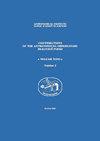改进的猎户座Delta模型
IF 0.2
4区 物理与天体物理
Q4 ASTRONOMY & ASTROPHYSICS
Contributions of the Astronomical Observatory Skalnate Pleso
Pub Date : 2020-03-01
DOI:10.31577/caosp.2020.50.2.585
引用次数: 0
摘要
我们提出了一个改进的猎户座三角洲a三星模型。我们第一次能够解开光学光谱蓝色部分的非常弱的谱线,并推导出可靠的质量比q = 0.415。根据SMEI、MOST和BRITE卫星的光度测定,我们得到了这颗近距离双星的真实质量和半径。本文章由计算机程序翻译,如有差异,请以英文原文为准。
Improved model of Delta Orionis
We present an improved model of triple star Delta Orionis A. For the first time we were able to disentangle the very weak spectral lines of the secondary in the blue parts of the optical spectrum and derive a reliable mass ratio q = 0.415. Along with light-curve solutions, based on photometry from the SMEI, MOST and BRITE satellites, we obtained realistic masses and radii of both components of the close binary.
求助全文
通过发布文献求助,成功后即可免费获取论文全文。
去求助
来源期刊
CiteScore
1.10
自引率
20.00%
发文量
4
审稿时长
>12 weeks
期刊介绍:
Contributions of the Astronomical Observatory Skalnate Pleso" (CAOSP) is published by the Astronomical Institute of the Slovak Academy of Sciences (SAS). The journal publishes new results of astronomical and astrophysical research, preferentially covering the fields of Interplanetary Matter, Stellar Astrophysics and Solar Physics. We publish regular papers, expert comments and review contributions.

 求助内容:
求助内容: 应助结果提醒方式:
应助结果提醒方式:


